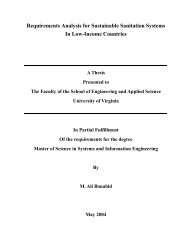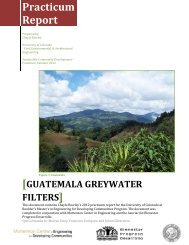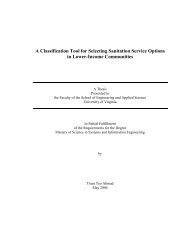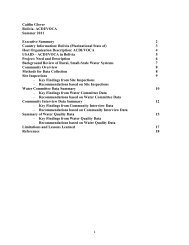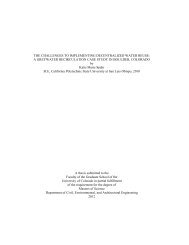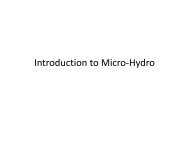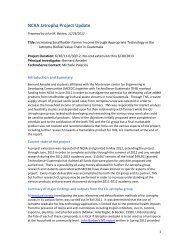SCEBs - University of Colorado Boulder
SCEBs - University of Colorado Boulder
SCEBs - University of Colorado Boulder
Create successful ePaper yourself
Turn your PDF publications into a flip-book with our unique Google optimized e-Paper software.
the sample and not the entire soil sample itself. The cohesive nature <strong>of</strong> clay supplies the<br />
binding forces between particles in the soil mix matrix. While a higher percentage <strong>of</strong><br />
clay would imply more cohesion and therefore a stronger SCEB, the silt portion also<br />
contributes to the range <strong>of</strong> particle sizes in the soil mix. The silt particles may increase<br />
the overall density <strong>of</strong> the SCEB, enhancing its performance. This topic needs to be<br />
researched further, before a definitive conclusion can be made regarding an ideal silt/clay<br />
ratio for a suitable soil in SCEB production.<br />
Percent Passing<br />
100%<br />
90%<br />
80%<br />
70%<br />
60%<br />
50%<br />
40%<br />
30%<br />
20%<br />
10%<br />
0%<br />
Grain Size Distribution Curve: "Sand 1 <strong>of</strong> 4"<br />
Percent Finer by Weight<br />
Silts & Clays Fine Sand Medium Sand Coarse Sand Gravel<br />
0.01 0.1 1 10<br />
Grain Size (mm)<br />
Figure 4.12: “Sand 1 <strong>of</strong> 4” Grain Size Distribution Curve<br />
4.2.2.2. Preparation <strong>of</strong> Soil Mixtures<br />
To illustrate the effects <strong>of</strong> varying the soil mix ratio on unconfined compressive<br />
strength, model-size (2.5” x 3.5” x 1”) <strong>SCEBs</strong> were produced. UMU soil Sample #11<br />
was used to produce mini-blocks in accordance with the procedure described in Section<br />
3.6. Four soil mixes with clayey soil to sand ratios varying from 1:2.5 to 1:4, were used<br />
45




